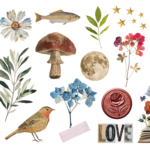My first collection was a sticker book. I loved to line the pages with scratch ‘n sniff or puffy vinyl, peeling each one and putting it in its perfect place. From there, I moved on to Garbage Pail Kids, had a suitcase full of Barbie dolls and eventually a nice collection of Julia Roberts movies on VHS. As a young mom, I collected trinkets from my kids — hospital bracelets, handprint art and handpicked flowers. And over the years, I’ve stored their school notes, artwork and trophies, hoping one day they’ll want to look back. A reader, my personal collection of books is more than I can possibly read in a lifetime. And my mom’s stuff — well, I’ve collected that, too.
Collecting, for many, is a way of saying to the world, “This is important to me,” or, “This is what I hold dear.” But unfortunately, in our high-consumer society, we’ve traded collecting mementos with collecting clutter, acquiring a whole slew of things that don’t always matter to us but take up our space and slowly steal our peace. And most of it is saved with the very best of intentions.
It’s the piles of papers we keep meaning to go through, the drawers full of missing pieces and parts we can’t throw away, and the jeans we’re keeping just in case they fit one day. It’s our inbox with 2,983 unread messages, totes full of old T-shirts we might make into a blanket and the RC car we know would be used, if we could just find the charger. It’s the last sweatshirt our mom wore, the hobbies we’ve abandoned and the gifts we got on sale but still haven’t found a person to give them to.
And though much of our clutter can be contained in totes or hidden behind closet doors or cabinets, it’s making a mess of our mental health. Living in a cluttered environment leads to more stress and less productivity. It impairs our ability to focus and heightens anxiety. It almost always assures we can’t find what we need when we need it.
But living with less leads to freedom. So, what do you do with all of your stuff? Do you hug it and ask yourself if it sparks joy, like Marie Kondo? Do you take Joshua Becker’s 12-12-12 challenge and locate 12 items to throw away, 12 to donate and 12 to be returned to their proper home? Or, like the book “The Gentle Art of Swedish Death Cleaning” suggests, do you start in a dumping zone like the garage, basement or attic, passing along your most treasured items to loved ones before you die?
I’m honestly not sure it matters, as long as you start. Clutter equals chaos. And the sooner you can get it under control, the better you will feel.
Here are five best practices to help you get started:
1. Start with Quick Wins.
There’s no need to overhaul the whole kitchen. Instead, start with a drawer. One drawer. Dump it out, wipe it down. Then decide what stays and what goes. Do not think too long or hard about this. Do not put extra pencils and pens in a Ziplock bag for storage. I repeat: Do not do it. Shuffling clutter between areas is still clutter. Set a timer and challenge yourself to complete the task in 10 minutes or less, then pat yourself on the back.
2. Know your limits.
We all keep things because “one day” we might need it, or “someday” we will get around to it. But I’m here to tell you, time doesn’t slow down. The more time that passes, the less likely you are to use it, fix it or even know where to find it. For that reason, I challenge you to move it out. Keeping something “just because” might make you feel better in the moment, but eventually, someone you love is going to have to deal with it and will be facing the same decision you are avoiding right now.
3. Rather than put it down, put it away.
Raise your hand if you have a “laundry” chair, table or treadmill where you keep unfolded laundry before you put it away. Yep, that’s what I thought. We all suffer from setting things down with the intent to come back to it later. I set my recycling by the back door, when I could easily carry it out to the bin. My son’s clothes go on the staircase, rather than making the trip to his room. Dishes get rinsed and set next to the sink, instead of going straight into the dishwasher. Want a less cluttered space? Make sure each item has a home, and take it right back or put it away when not in use.
4. Take a picture, toss the art.
Kids and grandkids are notorious for making pictures, writing notes and bringing home art projects from school. We love the people who made them, so it’s tough not to keep their gifts. But little knick knacks often clutter up our counters, fridges and bins. So, what do we do? Rent a storage unit? No! Some art we frame, a few pieces we might save, but take a picture of everything else and toss the actual item. Then, by our actions and our words, we kindly teach the next generation about unintentional clutter.
5. Buy less.
People living a minimalist lifestyle will tell you, if something comes in, then something goes out. Plain and simple. Your clutter will be a revolving door until you learn to stop buying things you don’t need. While bright and shiny on the front porch feels more comforting than the box of dull and dingy in the basement, eventually, the newness wears off. Set limits on your stuff, and find freedom in how much time and money you save.
An Interactive Decluttering Challenge
Clutter is not one-size-fits-all, but most of us could benefit from reducing clutter in a few key areas. Use this checklist to help you get started.
Quick Wins
- Clear one junk drawer
- Throw away expired pantry items
- Clean out your purse or backpack
- Tackle the “laundry” chair/table/treadmill
- Delete 100 emails
Gaining Momentum
- Organize kitchen cabinets
- Clean out refrigerator and freezer
- Minimize makeup and skincare products
- Simplify arts and crafts supplies
- Clear car clutter
Clearing the Stuff We Keep Hidden
- Toss out old and expired medication
- Clean out nightstands
- Sort the linen closet
- Reclaim a shelf in the garage
- Unsubscribe from 10 junk emails
Eliminating the Just-in-Case
- Donate five or more clothing items that do not fit
- Toss broken items you’ve been meaning to fix
- Clear duplicate photos on your phone
- Shred or recycle outdated paperwork
- Dump the box of random device cords
The Emotional Stuff
- Snap pictures of art projects, then toss the art projects
- Clear out old DVDs, CDs and VHS tapes
- Regift items that just weren’t right for you
- Downsize kids’ memory boxes to a few items per year
- Donate at least 10 books

